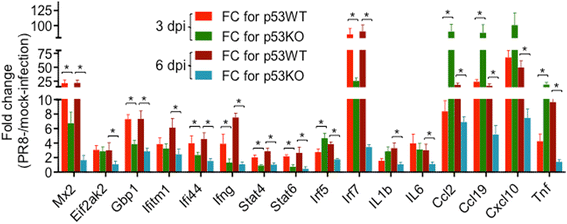Transcriptional analysis of immune-related gene expression in p53-deficient mice with increased susceptibility to influenza A virus infection
- PMID: 26282854
- PMCID: PMC4539693
- DOI: 10.1186/s12920-015-0127-8
Transcriptional analysis of immune-related gene expression in p53-deficient mice with increased susceptibility to influenza A virus infection
Abstract
Background: p53 is a tumor suppressor that contributes to the host immune response against viral infections in addition to its well-established protective role against cancer development. In response to influenza A virus (IAV) infection, p53 is activated and plays an essential role in inhibiting IAV replication. As a transcription factor, p53 regulates the expression of a range of downstream responsive genes either directly or indirectly in response to viral infection. We compared the expression profiles of immune-related genes between IAV-infected wild-type p53 (p53WT) and p53-deficient (p53KO) mice to gain an insight into the basis of p53-mediated antiviral response.
Methods: p53KO and p53WT mice were infected with influenza A/Puerto Rico/8/1934 (PR8) strain. Clinical symptoms and body weight changes were monitored daily. Lung specimens of IAV-infected mice were collected for analysis of virus titers and gene expression profiles. The difference in immune-related gene expression levels between IAV-infected p53KO and p53WT mice was comparatively determined using microarray analysis and confirmed by quantitative real-time reverse transcription polymerase chain reaction.
Results: p53KO mice showed an increased susceptibility to IAV infection compared to p53WT mice. Microarray analysis of gene expression profiles in the lungs of IAV-infected mice indicated that the increased susceptibility was associated with significantly changed expression levels in a range of immune-related genes in IAV-infected p53KO mice. A significantly attenuated expression of Ifng (encoding interferon (IFN)-gamma), Irf7 (encoding IFN regulator factor 7), and antiviral genes, such as Mx2 and Eif2ak2 (encoding PKR), were observed in IAV-infected p53KO mice, suggesting an impaired IFN-mediated immune response against IAV infection in the absence of p53. In addition, dysregulated expression levels of proinflammatory cytokines and chemokines, such as Ccl2 (encoding MCP-1), Cxcl9, Cxcl10 (encoding IP-10), and Tnf, were detected in IAV-infected p53KO mice during early IAV infection, reflecting an aberrant inflammatory response.
Conclusion: Lack of p53 resulted in the impaired expression of genes involved in IFN signaling and the dysregulated expression of cytokine and chemokine genes in IAV-infected mice, suggesting an essential role of p53 in the regulation of antiviral and inflammatory responses during IAV infection.
Figures


Similar articles
-
Single-walled carbon nanotubes modulate pulmonary immune responses and increase pandemic influenza a virus titers in mice.Virol J. 2017 Dec 22;14(1):242. doi: 10.1186/s12985-017-0909-z. Virol J. 2017. PMID: 29273069 Free PMC article.
-
CLEC5A-Mediated Enhancement of the Inflammatory Response in Myeloid Cells Contributes to Influenza Virus Pathogenicity In Vivo.J Virol. 2016 Dec 16;91(1):e01813-16. doi: 10.1128/JVI.01813-16. Print 2017 Jan 1. J Virol. 2016. PMID: 27795434 Free PMC article.
-
Myeloid TBK1 Signaling Contributes to the Immune Response to Influenza.Am J Respir Cell Mol Biol. 2019 Mar;60(3):335-345. doi: 10.1165/rcmb.2018-0122OC. Am J Respir Cell Mol Biol. 2019. PMID: 30290124 Free PMC article.
-
Molecular pathogenesis of influenza A virus infection and virus-induced regulation of cytokine gene expression.Cytokine Growth Factor Rev. 2001 Jun-Sep;12(2-3):171-80. doi: 10.1016/s1359-6101(00)00026-5. Cytokine Growth Factor Rev. 2001. PMID: 11325600 Review.
-
Host microRNAs and exosomes that modulate influenza virus infection.Virus Res. 2020 Apr 2;279:197885. doi: 10.1016/j.virusres.2020.197885. Epub 2020 Jan 22. Virus Res. 2020. PMID: 31981772 Review.
Cited by
-
Survival analysis of genome-wide profiles coupled with Connectivity Map database mining to identify potential therapeutic targets for cholangiocarcinoma.Oncol Rep. 2018 Dec;40(6):3189-3198. doi: 10.3892/or.2018.6710. Epub 2018 Sep 18. Oncol Rep. 2018. PMID: 30272356 Free PMC article.
-
p53 and the Viral Connection: Back into the Future ‡.Cancers (Basel). 2018 Jun 4;10(6):178. doi: 10.3390/cancers10060178. Cancers (Basel). 2018. PMID: 29866997 Free PMC article. Review.
-
Gallid Herpesvirus 1 Initiates Apoptosis in Uninfected Cells through Paracrine Repression of p53.J Virol. 2018 Aug 29;92(18):e00529-18. doi: 10.1128/JVI.00529-18. Print 2018 Sep 15. J Virol. 2018. PMID: 29950417 Free PMC article.
-
Long story short: p53 mediates innate immunity.Biochim Biophys Acta. 2016 Apr;1865(2):220-7. doi: 10.1016/j.bbcan.2016.03.001. Epub 2016 Mar 4. Biochim Biophys Acta. 2016. PMID: 26951863 Free PMC article. Review.
-
Tumor-associated macrophages (TAMs): Constructing an immunosuppressive microenvironment bridge for pancreatic ductal adenocarcinoma (PDAC).Cancer Pathog Ther. 2024 Jul 23;3(3):183-196. doi: 10.1016/j.cpt.2024.07.004. eCollection 2025 May. Cancer Pathog Ther. 2024. PMID: 40458305 Free PMC article. Review.
References
Publication types
MeSH terms
Substances
LinkOut - more resources
Full Text Sources
Other Literature Sources
Research Materials
Miscellaneous

